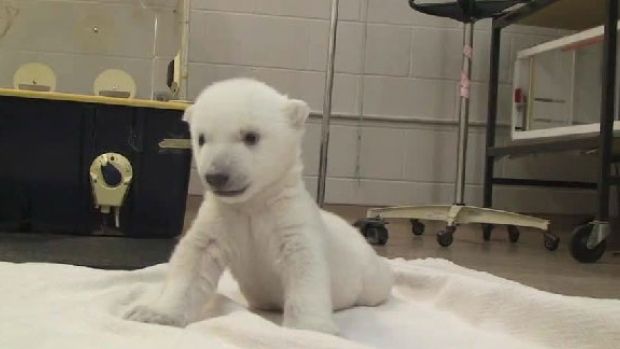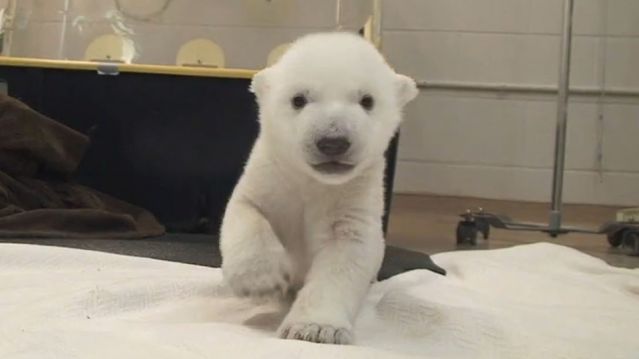Memes
Why Do Polar Bear Cubs (and Babies) Crawl Backwards?
Viral video captures early milestones of motor development.
Posted January 13, 2014
This YouTube video was viewed over 4.5 million times in the first 4 days since it was posted - and is sprouting all over the internet! The video shows a three-month-old polar bear taking his first wobbly steps at the Toronto Zoo.
One thing I noticed immediately is that the baby polar bear is crawling backwards.
At 0:18, he hoists himself up on four legs. From 0:22 to 0:33, his limbs move in the pattern of a backward crawl.
Many (human) infants do the same - crawling backwards before they crawl forwards!
Why is it common for polar bear cubs, human infants, and the young of many other four-limbed species to initially crawl backward?
Playing It Backwards
A key to this puzzle is to understand that early physical development follows a cephalocaudal principle. In other words, muscle strength and ability to control movement progresses from head to foot.
What this means is: Early in life, the upper limbs are much stronger and more well-coordinated than the lower limbs.
This is clearly demonstrated in the polar bear cub: His front limbs are outstretched and already good at supporting his heavy head - while his back limbs are much more frail, often crumpling and collapsing beneath him.

Cub's front limbs are much stronger than hind limbs. Image from Toronto Zoo video at https://www.youtube.com/watch?v=OkfEChXa2V0
As we see in the photograph: With stronger front legs pushing forward - and much weaker hind legs - the cub's movements tend to shift his body backward!
Notice especially the cub's weak right hind leg, which remains almost anchored to the ground. This is the main reason the polar bear pivots to his left during the backward crawl at 0:22 to 0:33 in the video.
Cub's right hind leg strength still developing. Image from Toronto Zoo video at https://www.youtube.com/watch?v=OkfEChXa2V0

Cub's right hind leg strength still developing. Image from Toronto Zoo video at https://www.youtube.com/watch?v=OkfEChXa2V0
Putting it all together
Searching YouTube for “Baby crawling backwards” brings up hundredsof amusing videos. People are often surprised or puzzled to see infants moving in reverse! But this is a normal phase of learning to self-locomote, observed in many babies around the world.
For instance, this infant tries her best to make her way toward a toy - but shifts backward, further and further away from her goal!
Like the typical young infant expressing the cephalocaudal principle of growth, her upper body is much stronger than the lower body. Her legs wiggle a lot but the weight-bearing is mainly left to the arms. As we see in this video, when pushing arms against a slippery floor while legs are not yet engaged, the arm motions naturally push the whole body BACK.
While the first infant ( above ) pushes with both arms at the same time, this second infant ( below ) already coordinates her arms to alternate left and right, left and right ... But each arm pushes up away from the body (which slides her back) rather than down toward the body (which would pull the carriage forward). So she's moving a lot faster - but still going backward!
To crawl forward, one must develop enough strength and control in the legs to propel the body forward. And arm movements must change from simply pushing away from the body - to a more complex pattern that resembles reaching with alternating left and right arms.
We can observe this turning point in the polar bear cub. At 0:22-23, he is mainly pushing outward with his front legs - which moves him backward.
But at 0:47, it is the first time the cub starts to bring one front paw down in a swinging motion toward his belly, which could propel him forward. However, the push from the hind legs is still too weak, and he makes little forward progress. This will come with practice!

Cub attempting forward crawl. Image from Toronto Zoo video at https://www.youtube.com/watch?v=OkfEChXa2V0
The stronger upper body/weaker lower body trend does not apply throughout life. In humans, as babies develop weight-bearing abilities such as pulling up to a stand and taking first steps upright, the lower limbs rapidly become stronger and more controlled.
No Two are Exactly Alike
Every infant progresses through self-locomotion in a different way. Some crawl backwards before forwards. Some ‘low crawl’, dragging bellies on the ground as they paddle (forward or backward) with four limbs.
Some infants 'commando crawl' - pulling themselves forward with their arms, and their legs simply drag behind them. Here we see the cephalocaudal principle illustrated clearly, as the upper body is clearly stronger than the lower body in the 'commando crawl':
Some ‘bear crawl’ on two hands and two feet - often in outdoor settings, where rough terrain may be uncomfortable on soft knees.
Some babies don't crawl at all, preferring to roll around from place to place, or scoot on their bottoms, or invent many other ways to move.
Here’s an infant who gets around by rolling -
And one who scoots backward -
And this amusing clip shows what hard work it is to learn to crawl!
As I often tell my Developmental Psychology students, if you look closely enough, every infant self-locomotes in a unique way. No two crawlers, rollers, or scooters are exactly alike! The placement of hands, angle of feet, order of movement of the four limbs, and a myriad of other factors, vary in subtle ways - based on our own unique attributes and adaptation to our individual physical and social environments.
Dr. Karen Adolph's brilliant research on the development of crawling marvelously captures this complexity. (Click here for one of her papers).
Even when taking our very first steps in life ... polar bear cubs and human babies show remarkable individual variation, ingenuity, and versatility.
=== To read my analysis of another "viral video", please click here
- © 2014 Siu-Lan Tan Ph.D, first author of Psychology of Music: From Sound to Significance (Psychology Press 2010, 2013) and primary editor of The Psychology of Music in Multimedia (Oxford University Press 2013).
My What Shapes Film? blog can be found by clicking here.
Videoclips
Original YouTube clip: Cubs first steps, posted by Toronto Zoo https://www.youtube.com/watch?v=OkfEChXa2V0
For video updates on this cub from the Toronto Zoo: http://www.torontozoo.com/polarbearcub/?pg=Video
Crawling backwards, posted by Lindsay Curtis https://www.youtube.com/watch?v=FFnCWbOtiT8
Moon crawler, posted by Kiki Storer https://www.youtube.com/watch?v=9rMaN37WE1c
Commando crawler, posted by Carley V, https://www.youtube.com/watch?v=EbEFaVh1a8I
Bear crawl, posted by Tommy Vadell https://www.youtube.com/watch?v=TBmfeECk6-4
Why crawl when you can roll? Posted by Karin Carr https://www.youtube.com/watch?v=9c2mc83QmIY
Baby scooting backward, posted by Kkanamon https://www.youtube.com/watch?v=2DpLVCk37Yk
Sleeping crawling, posted by alexbradley84 https://www.youtube.com/watch?v=I6zd7YYYQY4
Reference to Dr Karen Adolph's study
Adolph, K. E., Vereijken, B., & Denny, M. (1998). Learning to crawl. Child Development, 69, 1299-1312. Click here
More papers by Dr Adoph can be found on her site here.




